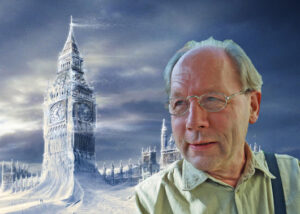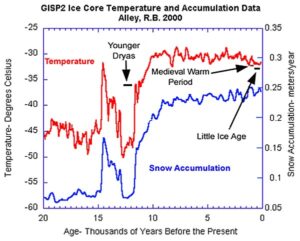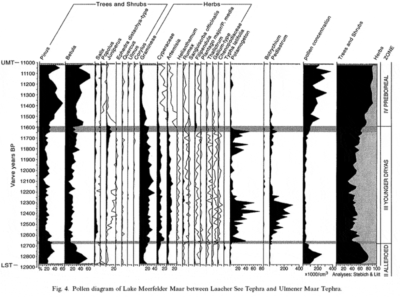Researching discrepancies of the Arctic isotope paleothermometer versus other climate reconstructions during the Younger Dryas.
Category: Paleoclimate

This is the second post in series with the objective of revisiting the Pleistocene ice ages, demonstrating that several well-accepted scientific practices don’t hold up very well in the big picture. We will examine possible flaws in current mainstream theories. One of those is the isotope thermometer of the ice cores.
Abstract
The Anthropogenic global warming view has its roots in the climate reconstructions based on the ice core records of Antarctica and Greenland. However there are some periods in which field evidence does not concur with isotope-derived temperatures of the ice cores. Here we investigate the Younger Dryas, 12.9-11.5 thousand years ago showing substantial discrepancies. It is shown that the large isotope swings at the Younger Dryas boundaries could be much more consistent with arid/moist swings. This would invalidate the isotope thermometer of the ice cores.
Samenvatting
De antropogene global warming hypothese heeft zijn wortels in de klimaatreconstructies op basis van de ijskernregistraties van Antarctica en Groenland. Er zijn echter enkele perioden waarin resultaten uit veldonderzoek elders niet overeenkomen met de isotoop-afgeleide temperaturen van de ijskernen. Hier onderzoeken we het Younger Dryas, 12,9 – 11,5 duizend jaar geleden, met substantiële afwijkingen. Er wordt aangetoond dat de grote variatie van de isotopen aan het begin en einde van het Younger Dryas veel beter overeenkomen met schommelingen tussen grote droogte en natte periodes. Dit staat op gespannen voet met de isotopen-thermometer van de ijskernen.
Introduction
The Younger Dryas, 12.9-11.5 thousand years ago, is one of the most intensely investigated ‘stadials’ of the Pleistocene. It’s believed to be a period of an intense cold snap reversing the warming after the Last Glacial Maximum with re-advancing ice sheets. Also its cause is hotly debated, an extraterrestrial event may or may not have been involved, also are mentioned an excessive drainage of melt water and the mega-volcanic eruption of the Laacher See in the Eifel in Germany, which may have caused substantial cooling, i.e. years without summers. However we limit this study to the climate conditions only, to investigate whether or not the ice cores of Greenland correctly reflect the condition on the northern hemisphere.

Fig 1 Reconstruction of “temperatures” and snow accumulation of the GISPII ice cores of Greenland
Fig 1 shows a fragment of data processing of a Greenland ice core from Alley[i] The red graph “temperature” is actually a calculation based on the isotope ratio, δ18O. It shows the Younger Dryas both cold and dry with very little snow accumulation.
The case for a cool Younger Dryas
Early research inferred that there have been large climate swings with a distinct cooling period at the end of the Pleistocene. However precision dating tool like calibrated carbon dating or dendrochronology became only available in the second half of the 2oth century, when also ice cores data became available. A landmark study about insect remains in the United Kingdom was Atkinson[ii], which seemed to tie this cold snap (Loch Lomond stadial) to the isotope minimum around 12,000 years ago, with a seemingly good match. Note also that this marks the preceding period, the Allerød, as a warmer period.
However, as fieldwork progressed, conflicting evidence accumulated. Much research revealed glacial readvances elsewhere predated the Younger Dryas ie The Two Creeks glacial readvance in the USA was carbon dated ‘12,050 to 11,750 yr B.P.’ by Kaiser 1994[iii] which calibrates to 13,895 to 13,565 calendar dates using the Intcal13 table of Reimer et al. Furthermore Eamer[iv] dated glacial readvances and subsequent retreats in the Rocky Mountains (Cordelerian ice sheet) to 14,200 and 13,800 calendar dates, Lohne[v] conclude that the glacial re-advance in Scandinavia commenced “possibly more than 600 years before the Allerød /YD transition”.
Björck[vi] finds also somewhat different situation on research he conducted in Greenland which suggest that the Younger Dryas summers were mild but arid:
“the data imply that the conditions in southernmost Greenland during the Younger Dryas stadial, 12 800–11 550 calendar yr B.P., were characterized by an arid climate with cold winters and mild summers, preceded by humid conditions with cooler summers.”
They give a modeled föhn effect to explain their anomaly away. However it explains exactly what the isotopes are telling us too. Dry summers tilt the isotope balance on the ice cores, showing only the cold winter and suggesting a cold snap instead. For Alaska, Ager[vii] wonders “it is unclear why an interval of apparently colder, drier climate might favor the expansion of Populus and Salix populations, even into areas beyond the present day range of Populus trees.”

Fig 2 Pollen Diagram of the Meerfelder Maar (Lucke & Brauer 2004) generally showing that forest dominance swapped into steppe dominance at the onset of the Younger Dryas with typical taxa that are around nowadays as well. Typical Arctic taxa are lacking. The genus Helianthemum is thriving in moderate to mediterranian climate conditions.
See also the presentation of Walters at GSA 2012:
“Prior work suggests that the Younger Dryas caused the LIS to readvance a substantial distance. This would agree with Greenland ice core data which indicates near-full-glacial conditions. However, multiple ice margins between the YD limits allows for alternative possibilities, one of which is that the LIS retreated in steps during the YD. If so, this implies warmer summers during the Younger Dryas, as has been reported in Greenland and Scandinavia.”
Indeed Lücke and Brauer[viii] found another example of similar climate swings in the pollen diagram of the Meerfelder maar in central Germany, suggesting that the summers were warm during the Younger Dryas (fig 2). Also Schenk[ix] came to the same conclusion recently
Concequently, the alleged extreme cold for the Younger Dryas as assessed by the d18O were not supported by much other fieldwork in the northern hemisphere, instead advancing glaciers during the preceding Allerød suggest that this period was cooler and/or more moist than the Younger Dryas.
The case for an arid Younger Dryas
Dreimanis 1968 mentioned early research that found an arid period between 11,000 and 10,000 radiocarbon years ago (calibrates to 12,800 to 11,400 calendar years, the Younger Dryas), to which he attributed the extinction of the mastondon in the USA. Then, as fig 1 shows, the snow accumulation on the Greenland Ice sheet was a mere fraction of accumulation during the following Holocene, which suggest generally arid conditions and confirmed by Björckvi. Retreating ice sheets ar reported by Walters, Eameriv, Lohnev during the Younger Dryas would also suggest aridity as evaporation and melting would exceed accumulation. Furthermore the pollen diagram of the Meerfelder maar shows water vegetation blooming during the Younger Dryas, suggesting marsh/swamp forming and obviously a lake low stand. It’s also noted that the Sahara, during a distinct moist period, suffered from substantial aridity during the Younger Dryas as mentioned in a former blog, confirmed by lake low stands (Garcina[x]). Also Van der Hammen and Hooghiemstra[xi] mention lake low stands in Columbia. Hence aridity can be found on a large scale in the Northern Hemisphere during the Younger Dryas.
Conclusion
The Younger Dryas was a remarkable event at the end of the Holocene. It’s generally considered to be a cold event with a brief return to glacial conditions. Detailed dating however shows that the associated glacial re-advances occurred in the preceding period, the Allerød, with widespread evidence of retreat of those glaciers during the Younger Dryas. Furthermore, other field evidence does not generally indicate a cold period. Instead, there are widespread indications that the Younger Dryas was generally much more arid than the previous Allerød and the succeeding Holocene.
These results again do not support the isotope thermometer of the ice cores. Instead it appears that the “cold” isotopes in the ice cores (fig 1) may very well be arid isotopes instead. In the next contribution we will go into the details of the isotope fractionation processes to see if this makes sense.
Notes and References
[i] Alley, R.B. 2000. The Younger Dryas cold interval as viewed from central Greenland. Quaternary Science Reviews 19: 213-226.
[ii] Atkinson, T. C., Briffa, K. R., & Coope, G. R. (1987). Seasonal temperatures in Britain during the past 22,000 years, reconstructed using beetle remains. Nature, 325(6105), 587–592.doi:10.1038/325587a0
[iii] Kaiser, K.F. 1994 Two Creeks Interstade Dated through Dendrochronology and AMS, Quaternary Research, Volume 42, Issue 3, November 1994, Pages 288-298
[iv] Eamer, J.B.R. et al 2017 A glacial readvance during retreat of the Cordilleran Ice Sheet, British Columbia central coast; Quartenary Research, Volume 87, Issue 3 May 2017 , pp. 468-481
[v] Lohne, Ø. S., S. Bondevik, J. Mangerud, J. I. Svendsen, 2007. Sea-level fluctuations imply that the Younger Dryas ice-sheet expansion in western Norway commenced during the Allerød, Quaternary Science Reviews 26 (2007) 2128–2151
[vi] Björck, S., Bennike, O, Rosén P., Andresen, C.S., Bohncke S., Kaas E., Conley., 2002. Anomalously mild Younger Dryas summer conditions in southern Greenland. Geology; May 2002; v. 30; no. 5; p. 427–430.
[vii] Ager T.A. 2003, Late Quaternary vegetation and climate history of the central Bering land bridge from St. Michael Island, western Alaska ; Quaternary Research,
Volume 60, Issue 1, July 2003, Pages 19-32
[viii] Lücke, A., Brauer, A., 2004. Biogeochemical and micro-facial fingerprints of ecosystem response to rapid Lateglacial climatic changes in varved sediments of Meerfelder Maar (Germany). Palaeogeogr. Palaeoclimatol. Palaeoecol. 211, 139e155.
[ix] Schenk, F., Väliranta, M.,Muschitiello, F., Tarasov, L. Heikkilä, M., Björck, S,. Brandefelt,J., Johansson, A.V. Näslund, J-O,. Wohlfarth, B. 2018 Warm summers during the Younger Dryas cold reversal Nature Communications 9, Article 1634
[x] Garcina, Y, A. Junginger, D. Melnick, D.O. Olago, M.R. Strecker, M.H. Trautha 2009 Late Pleistocene–Holocene rise and collapse of Lake Suguta, northern Kenya Rift, Quaternary Science Reviews, Volume 28, Issues 9–10, May 2009, Pages 911-925
[xi] Van Der Hammen, T., & Hooghiemstra, H. (1995). The EL abra stadial, a younger dryas equivalent in Colombia. Quaternary Science Reviews, 14(9), 841–851. doi:10.1016/0277-3791(95)00066-6
- Edit: added Dreimanis as reference:
Dreimanis, A. 1968. Extinction of mastodons in eastern north america: testing a new climatic environmental hypothesis, the Ohio Journal of Science vol. 68 november, 1968 no. 6
